Fasten your seatbelts and place your tray tables into their upright positions…we’re about to take a look at “Airlines Europe”, a board game that deals with airline companies, stocks, and quite a bit of strategy. In “Airlines Europe”, you’ll be attempting to earn the most victory points by having the most shares in the most successful airlines on the playing board. Let’s take a quick look at the components and how the game is played before heading into the review.
Editor’s Note: I published a review for this game years ago, but felt it could be better. As such, this article will serve to modernize my older (AKA crappier) review and bring it up to date with my current review format. The old review has been retired.
Components
Game Board – The playing board contains a map of Europe, complete with airport locations and routes. A scoring track is laid out along the perimeter, allowing players to keep track of the progress that the various airlines are making throughout the game.
Share Cards – There are over a hundred share cards that come in a variety of colors. Each color represents a particular airline and it’s worth noting that some airlines have more share cards than others.
Airplanes – Airplanes come in a variety of colors that, like share cards, also represent a particular airline. They are placed on the board during the game to signify a particular airline’s footprint across the map.
Company Markers – There are two company markers of each color. One represents an airline’s starting location on the map while the other serves as a scoring token that moves along the scoring track.
Victory Tokens – Players will be attempting to earn these to win the game.
Score Cards – These three cards are placed in the share deck and serve as a stopping point for players to earn victory points.
Paper Money – Players will be earning and spending money throughout the game.
Bonus Connection Markers – There are four bonus markers for the four smallest airlines in the game (the ones that have the least amount of share cards/planes). These airlines earn bonus points for connecting these particular routes.
Game Summary Cards – Each player receives one to help remind them of what they can do on their turn, among other things.
Setup & Gameplay
The game setup is over a page and a half long, so I’ll simply refer you to the manual below. To sum things up, the share deck will be seeded with the three scoring cards, players will be given both money and share cards to get their portfolio’s started, and the board will be set up appropriately with airlines and markers. How everything is set up factors heavily on how many people are playing the game.
The general idea behind the game is a simple one. You’ll be playing share cards from your hand in an effort to grow your portfolio (the area on the table in front of you). Your portfolio represents how much stock you have in any particular airline (cards in your hand don’t count). As airlines grow on the board, their respective scoring token moves up along the scoring track. The higher a scoring token gets along the track, the more victory points that are potentially awarded to the players that have the most share cards of that color. Thus, you’ll be trying to grow the companies in which you have a lot of stock.
On a player’s turn, a player may do ONE of the following:
1) Purchase a plane or two of a certain color, establishing new routes and increasing that company’s value and worth. This player may draw a share card after doing so.
2) Add cards to their portfolio, gaining two million Euro dollars per share card added. Players can either play ALL share cards of one color from their hand or two cards of different colors.
3) Trade cards from their hand or their portfolio for the invisible Air ABACUS share cards, using a ratio of 1:1 or 3:2. Air ABACUS is invisible on the playing board but represents a huge Walmart-esque airline that has its own scoring rules.
4) Gain eight million Euro dollars.
Victory points are awarded three times in the game as the three score cards are revealed in the share deck. During a scoring session, EVERY company on the board is looked at. Players earn points, the number of which depends on how many shares they have and how far up the scoring track a particular company is. Having the most share cards of a particular color doesn’t always mean you’ll get a lot of points, especially if the company is falling behind the others on the score track. The winner of the game is the player with the most victory points after the third scoring round.
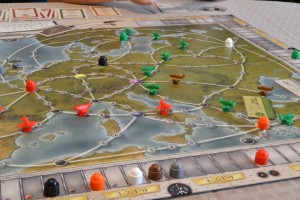
Green is taking an early lead. Needless to say, I made sure to bank five green share cards (there are only nine in the deck).
The above is simply an overview of the game, but should give you an idea of how it is played. You can check out the manual for more information here:
http://www.riograndegames.com/uploads/Game/Game_388_gameRules.pdf
The Review
Firstly, I want to praise the game for having a great tray insert for the pieces. The pieces themselves were bright and colorful, as were the cards. My only complaint was that it was hard to tell the difference between the red and orange planes. The manual did a good job in explaining the rules, but I was forced to re-read it multiple times before everything clicked. Along that note, this game was a lot to take in at first. The above doesn’t cover all of the nitty-gritty details, which may serve to overwhelm new players. Our first play session lasted three hours and we were seeking water and Excedrin Migraine by the end of it. To be fair, we weren’t the budding board game connoisseurs that we are today. I think our biggest hurdle was getting around the fact that players didn’t get assigned any particular color. In games like “Ticket to Ride”, it’s clear as to who is who. “Airlines Europe” is more about observing all of the colors and making decisions based on what companies are pulling ahead of the others.
There’s a boatload of strategy in “Airline Europe”, mainly due to the fact that not all companies have the same amount of share cards. This brings company size into the mix. A company that has eight share cards is small compared to one that has sixteen. Having five share cards in a company that only has eight ensures that you’ll have no competition. You could, in that example, safely expand that airline without having to worry about someone dropping shares at the last-minute to steal your precious victory points during a scoring round. By the same token, if you have a significant amount of shares for a larger company in your hand, you could wait and let people spend money to expand it, and then lay your shares down later on which might trump everyone else. You may end up scoring the highest amount of victory points without spending a dime to expand that company.
Route cost is also a big part of the game, though it may not be apparent until you see the game in action. In order to get the company markers up the scoring track, players will need to create routes. The more expensive the route, the more the company marker moves up the track. Some companies only have about seven or eight planes, so if you buy a bunch of cheap routes without any real plan, they won’t make it far up the scoring track. The larger airlines (the airlines with more planes) can afford to let this slide a bit. Before buying a route, I check to see if the marker will hit the next tier on the scoring track, as well as whether or not I have the most share cards of that company.
At the time, Carolyn (13, now 15) compared the game to “Ticket to Ride”, but hated how long it took to play. Vinnie (10, now 12) voiced similar concerns, but enjoyed the airline theme and was really getting into it despite the recommended age barrier. I probably got more enjoyment out of the game than the other two, mainly because I really, really enjoy games that revolve around tactical planning and observation. “Chess” was the first board game I ever learned how to play and to be successful at it, you’ll need to plan ahead and observe the other player. “Airlines Europe” is similar in that regard. You’ll need to constantly adapt your strategies based around how the board is playing out and what shares the other players have in their portfolio. Tiring as it was to spend three hours on this game, I enjoyed every minute of it. It’s worth noting that Vinnie and I recently played the game again and we managed to knock the aforementioned three-hour play time in half.
I’d recommend this game to those who don’t mind a learning curve and enjoy analyzing things. This game may not be as complex as “Tigris and Euphrates” or “Agricola”, but it’s up there. Once you get the hang of how everything is set up and functions together, play times can be cut to the average play time that the box advertises. Until then, be sure to set aside some extra time while you’re learning the ropes. Those seeking instant gratification or hate thinking too much about the games they play may not take to “Airlines Europe” all that well. With enough patience and the proper parental support, it’s my belief that kids a few years under the recommended age can play. Ultimately, parents will need to make that decision since every child is different in terms of growth. Overall, it’s an excellent game and among my personal favorites.
Final Verdict: 8/10
—
You can learn more about the game by visiting the official site, here:
http://riograndegames.com/games.html?id=388
—

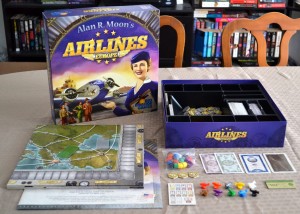
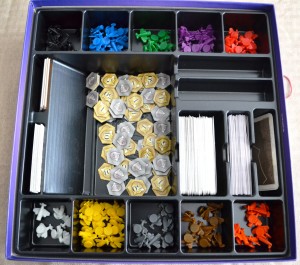
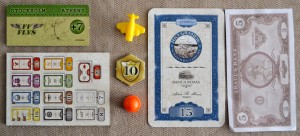
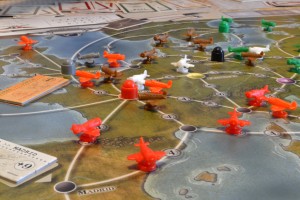
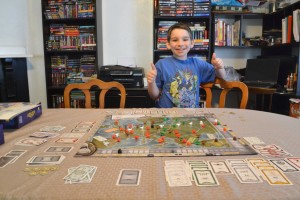
It’s a great game but there’s one thing that i can’t find an answer to.
At the start of the game you dish out victory points and keep them face down:
“Each player keeps his victory tokens face down in his play area (the space
near him on the table) so they are kept secret from the other players during the game.”
Thing is – at no point in the instructions does it say what you do with them!
Do they get turned over at the end as a surprise element to the game? What’s the point of them? Anyone got any ideas??
Yes, Victory tokens are flipped and counted at the end of the game. Keeping them hidden prevents other players from figuring out how many points you have during the game.